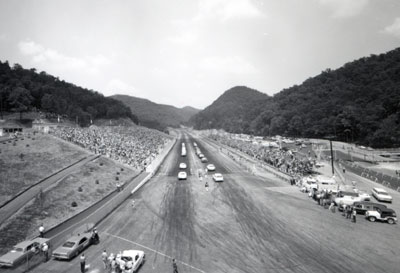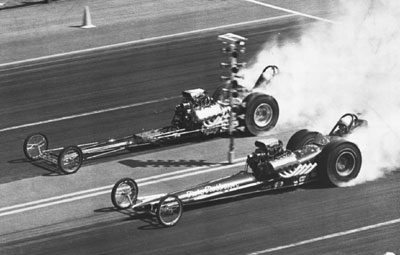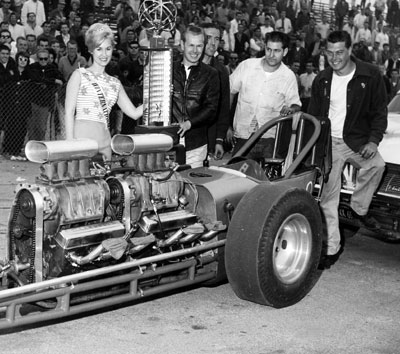

Looking forward to (and back at) Bristol
|
|
 |
Tomorrow, I’ll be winging my way east to Bristol for the annual O’Reilly NHRA Thunder Valley Nationals presented by Q, and I’m pretty excited to be going. It’s my first trip to Bristol Dragway and the majestic Thunder Valley of drag racing lore, where the sounds of engines bounce off the hills and the shutdown area carves a path between two mountains, earning the track its nickname. Brad Littlefield and Kelly Wade will be handling the words for ND and Marc Gewertz and Richard Wong the photos while I hold down the dot-com beat, and we’re all revved up to head out.
My trip was reason enough to delve into the history books for another the-way-it-was column that y’all seem to enjoy so much (do they say y’all in Tennessee?), but because this year’s race is justin its eighth appearance on the NHRA POWERade Drag Racing Series schedule (before that, in 1999 and 2000, the track hosted the offbeat yet cool Showdown between Top Fuelers and Funny Cars), I’d thought I’d dial the Wayback Machine just a little further into the past and head for the three-year span from 1965 through 1967, when the facility hosted the first NHRA Springnationals.
(Distracting trivia note: The term Wayback Machine comes from a cartoon on The Rocky and Bullwinkle Show featuring a professorial talking dog, Mr. Peabody, and his pet boy, Sherman, who used it to go back in time to relive historical moments. In the show, however, although the machine was pronounced “wayback,” its actual name was the WABAC machine, a sly nod to the UNIVAC and ENIAC computers that would have been its contemporary. Now you know … we now return you to your originally scheduled programming.)
When NHRA added the Springnationals to the schedule for the 1965 season, it was just the third event, joining the already legendary U.S. Nationals and Winternationals, in what NHRA dubbed drag racing's Triple Crown.
NHRA announced the event with great fanfare in late 1964, before the track was even completed, and track officials already were touting the new multimillion-dollar racing plant as “the most modern and complete dragstrip in the nation.”
Held in early June, Parks envisioned that the event would “round out our national championship program and give drag racers both a geographical and calendar balance of competition. The Winternationals will kick off the season, the Springnationals will provide a midseason challenge, and then we will wrap it up with the Nationals. These three major championship meets will not only produce some outstanding competition but will provide a yearlong check of performance progress throughout the country."
The dragstrip was built alongside the existing Bristol Motor Speedway circle track (then known as Bristol Int'l Raceway, which was constructed in 1960 and held its first NASCAR race in July 1961) and was noteworthy in that it included a crossover bridge for spectators, a four-story tower that housed offices, suites, the timing tower, and media accommodations “second to none,” officials bragged. Radio station WJCW in Johnson City, Tenn., broadcast the final four hours of the event live to an eight-state area, which was pretty much unheard of in those times but standard fare today for NHRA fans who can listen live via the Internet from NHRA.com.
I don’t want to say that those three years were haunted, but some mighty weird stuff happened in Bristol, especially in the final rounds.
Maynard Rupp won the inaugural Top Fuel title, wheeling the Logghe Stamping Co. entry to victory against the overhead-cam Ford dragster of current car owner Connie Kalitta in an all-Michigan match, but the event was most notable because co-champions were crowned in Comp when the final-round battle between Pete Shadinger and Glen Blakely was interrupted by a malfunction in the timing equipment. The B/A class title in Comp, by the way, went to a young circle-track racer from Level Cross, N.C., by the name of Richard Petty.
The 1966 event also had its share of interesting outcomes, as this time the Top Gas final featured a unique outcome. Mark Pieri red-lighted but was declared the winner when his opponent, Dick Vest, was disqualified for having loose ballast and was relegated to runner-up. One of the highlights of the event was an exhibition run by Jack Chrisman's famed Comet, a predecessor to today’s Funny Cars, which ran an 8.82 at 182 mph, the fastest speed ever recorded at a national meet by a stock-bodied car. Chrisman's Comet became the first car in the new Super Experimental Stock, or S/XS, class, which was created just after the Bristol event for cars with "excess engine relocations or modifications that otherwise render them illegal for A through E Factory Experimental Stock classes," but the entries were already being called "funny".
The Top Fuel final was no less remarkable. The “Smilin’ Okie,” the late Jimmy Nix, took Top Fuel against Ray Marsh, who was happy to just be in the final. In the semifinals, Julius Hughes should have battled Marsh for the right to face Nix in the final, but both of their mounts were broken, Hughes’ machine with a toasted clutch and Marsh's with a shelled rear end. Hughes’ car simply rolled to the starting line to become the runner-up, but in a display of sportsmanship, he conceded the race to Marsh, allowing Marsh the necessary pit time to replace his broken third member so that Nix would have an opponent. In another freak stat that drives historians nuts, Hughes was awarded "co-runner-up" status with Marsh.
|
|
In 1967, Top Fuel honors were captured by “the Snake,” Don Prudhomme, in what was just the third of his 49 wins. Prudhomme, like Kalitta two years earlier, was running an overhead-cam Ford fueler, and he defeated “Sneaky Pete” Robinson's similarly powered digger in the final. Prudhomme was just two years removed from his breakthrough 1965 season and was wheeling the Brand Ford entry for Lou Baney, tuned by Ed Pink.
The field featured a ton of hitters, including Tom Hoover (in another OHC Ford-powered digger), Mike Snively (driving Prudhomme’s former ride, Roland Leong’s Hawaiian), Tom McEwen (a longtime Goodyear tire tester who ignited a firestorm of controversy by running M&H tires on Don “the Beachcomber” Johnson’s entry), 1965 event runner-up Kalitta (like McEwen, on M&Hs), Chuck Kurzawa in the Ramchargers rail, 1966 Top Fuel winner Nix, Leroy Goldstein, and Californian Dave Beebe.
McEwen had the hot numbers early, much to the chagrin of the Goodyear engineers, with a 7.11, but Prudhomme, despite dealing with a cracked cylinder head, showed everyone the way home with an unprecedented string of six-second passes and capped it with a stunning sub-national-record 6.92 at 222.76 mph on just 85 percent nitro. National DRAGSTER dubbed him “King of the 6s” on the front page of the June 16, 1967, issue.
Also of note at that 1967 event, Tommy Grove captured the event’s first Funny Car title, defeating 1965 Top Fuel winner Rupp. Top Gas went to Bob Muravez, who was racing under the alias of Floyd Lippencott Jr. after his father had forbidden him to race.
|
|
Muravez, like Prudhomme, a member of the famed Burbank Road Kings car club (he actually was initiated at the same meeting when Prudhomme became a member), won Top Gas in Bakersfield, Calif., in 1962 but was under pressure from his father, who told him that if he wanted to keep working at the family’s Maytag dealership franchise and hoped to own it someday, he would have to quit racing, which he did for a short time before the siren call of the quarter-mile lured him back.
A young Steve Gibbs, in his pre-NHRA days, was the Drag News reporter for San Gabriel Drag Strip, and after Muravez won a race there, he implored Gibbs to use an alias. Hence, Floyd Lippencott Jr. was “born.”
“The Floyd part came out of thin air, but I borrowed the name Lippencott from a college textbook that was on my shelf,” recalled Gibbs. “I threw in the Junior part as an afterthought. The track announcer, Mel Reck, started using the name at subsequent events, and it stuck.”
After he won Top Gas at the 1963 Winternationals in John Peters’ fabled Freight Train twin-engine machine, Peters initially was listed as the winning driver before the Lippencott name was inserted.
It wasn’t until years later that records were amended to officially reflect Muravez, who also won Top Gas at the 1969 Springnationals, as the rightful champ. Muravez was most recently the grand marshal at the 2003 NHRA California Hot Rod Reunion presented by Automobile Club of Southern California.
The 1967 event also marked the beginning of a record-setting streak for southeast doorslammer legend Ronnie Sox, who won Super Stock that year and the Springnationals in each of the following four years, a feat not duplicated at any event until Bob Glidden won the Springnationals five straight years from 1979 through 1983. Sox won Super Stock at the 1967 event, then again at the 1968 race, which was held in Englishtown, and at the 1969 event, which was in Dallas, and then won Pro Stock at the 1970 and 1971 races, also held in Dallas. The event moved to Columbus, Ohio, in 1972.
Okay, class, history lesson over. I have a plane to catch. I'll write Friday from B-town.






















































